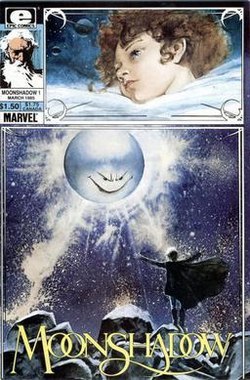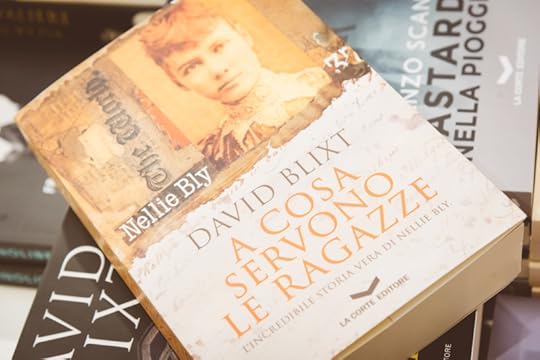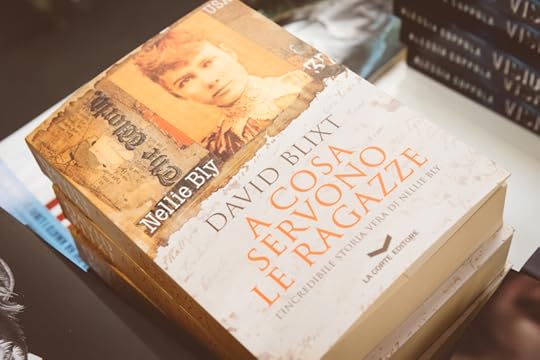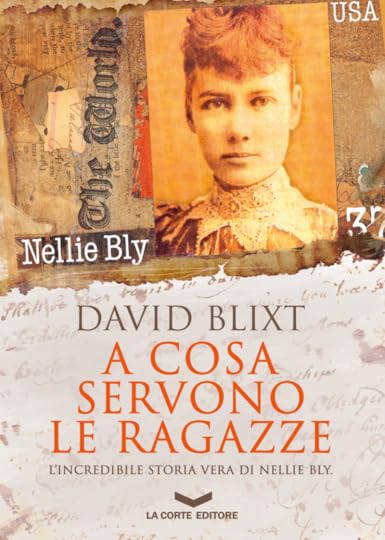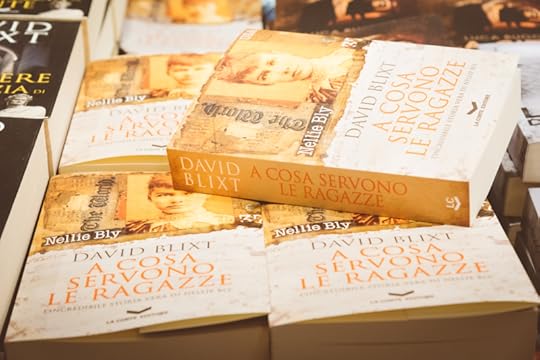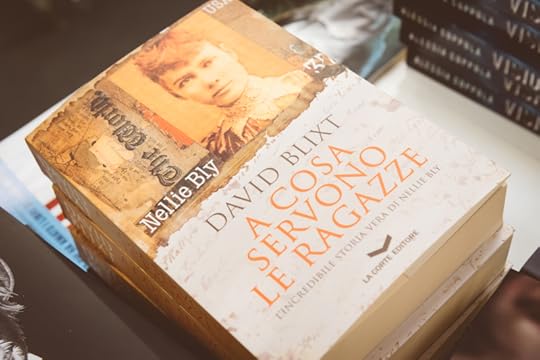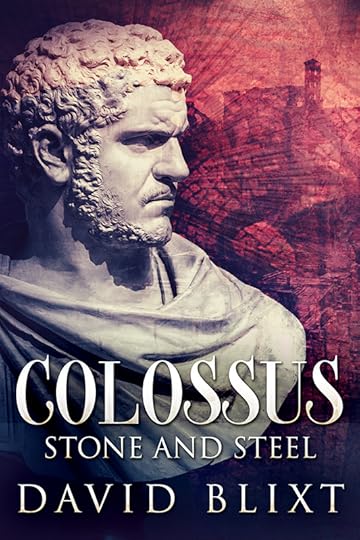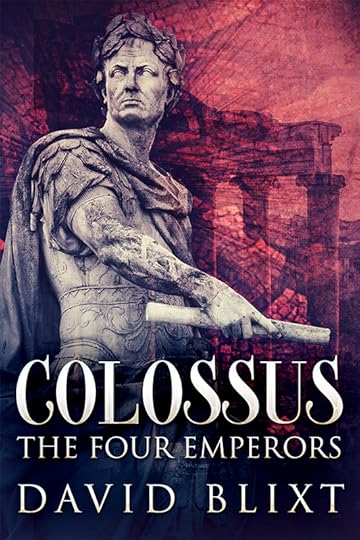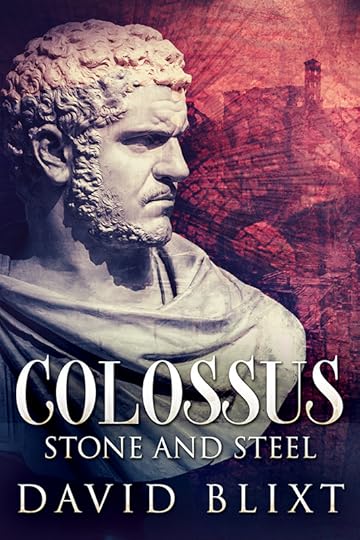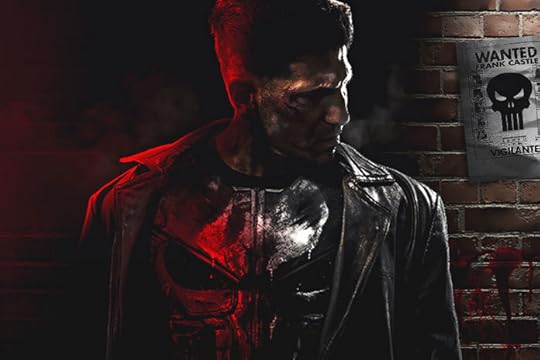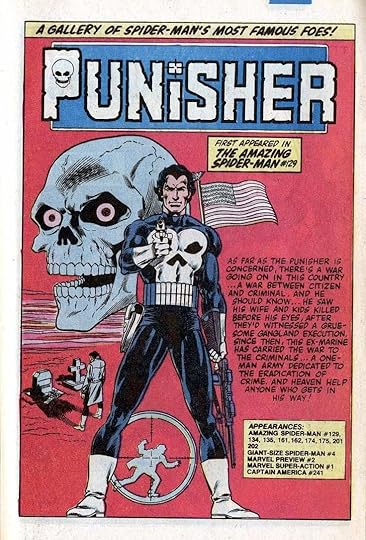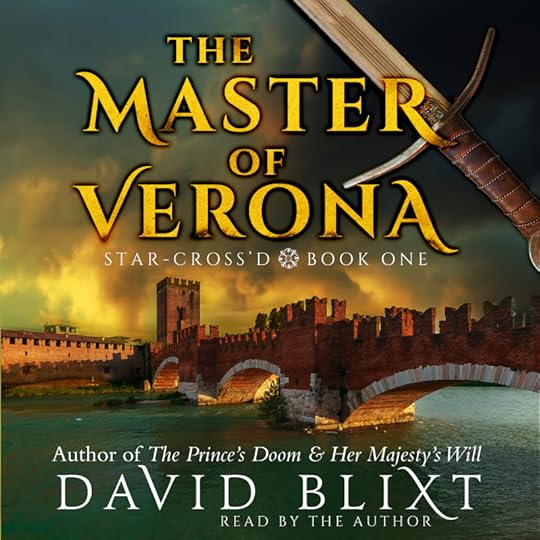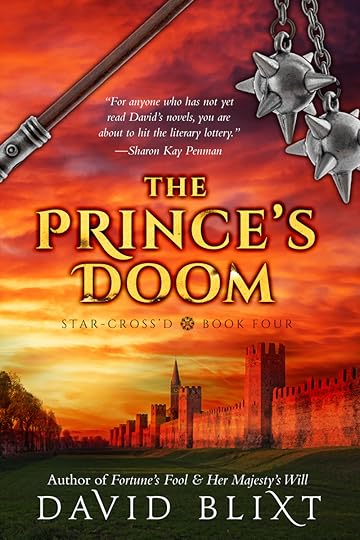David Blixt's Blog
September 27, 2018
Moonshadow In A Minor Key
My wife was playing Cat Stevens in the car this morning as she took the kids to school. Our 10 year old daughter, a fan of all things horror - even the stuff she's not allowed to see - was frightened by the song "Moonshadow."
I thought about the lyrics, and I can see her point:
Oh, I'm bein' followed by a moonshadow, moon shadow, moonshadow---
Leapin and hoppin' on a moonshadow, moonshadow, moonshadow---
And if I ever lose my hands, lose my plough, lose my land,
Oh if I ever lose my hands, Oh if I won't have to work no more.
And if I ever lose my eyes, if my colours all run dry,
Yes if I ever lose my eyes, Oh if I won't have to cry no more.
Oh, I'm bein' followed by a moonshadow, moon shadow, moonshadow---
Leapin and hoppin' on a moonshadow, moonshadow, moonshadow---
And if I ever lose my legs, I won't moan, and I won't beg,
Yes if I ever lose my legs, Oh if I won't have to walk no more...
Somebody, there's a hit horror version of this set in a minor key. Seriously.
And now I have to find my old Moonshadow comics...
September 22, 2018
Nellie Bly - The Research
For me, inspiration always comes from reading. Be it history, fiction, essays, or comics, I find my best ideas are sparked from gaps I discover in narratives. What was the cause of the famous Capulet-Montague feud? What was Shakespeare doing during his "lost" years? How did the destruction of Jerusalem influence the building of the Colosseum and the rise of Christianity? How did Nellie Bly get her first reporting job?
The answers to all these and more invariably came from research.
For WHAT GIRLS ARE GOOD FOR, I was blessed with a treasure trove of articles, both by Bly and about her. I owe a huge debt to Brooke Kroeger for sharing we 20 year-old research with me, especially a couple of important articles I was missing. I also owe thanks to Shanya Marie and Erika Lorraine for hunting up articles that live in the Pittsburgh Library, as well as the librarians there as well. Librarians are the best.
I'm always happy to share my research. ���To start off, here's a link to a page on my website where I've listed all the original sources for the novel. They're fascinating, especially the other newspapers writing about the "mysterious woman" who was sent to Blackwell's, and the bitter war for dominance of the story that followed.
September 21, 2018
Why Nellie Bly?
Late one April evening in 2016, sitting at my desk not writing, this article in The Atlantic caught my eye. The premise was that there were more female action stars 100 years ago than today. Most were in the mold of the Perils of Pauline, with an intrepid young woman leaping off horseback or clinging to the side of a train. From the article:
"In 1914, a breakout year for the category, the actress Mary Fuller played a daring reporter in The Active Life of Dolly of the Dailies. The same year, Grace Cunard appeared in Lucille Love, The Girl of Mystery, which was billed as the ���Most Sensational Series of Pictures Ever Produced ��� AEROPLANES���LION���TIGERS���CANNIBALS���SHIPWRECKS ������ Also in 1914, Pearl White, perhaps the best-remembered serial queen of all, made headlines as the fearless heiress Pauline Marvin in The Perils of Pauline, and Helen Holmes began her stint as the brave railroad telegrapher in The Hazards of Helen, which went on to become the longest-running serial, with 119 episodes over six years."
Intrigued, I started looking up these films only to discover most of the daring fictional females portrayed were newspaper reporters. Of them, the majority were based on Nellie Bly.
The name rang a very specific bell. In the second season of the television show The West Wing, the President���s amorous intentions are thwarted when he belittles the achievements of Nellie Bly, whose statue the First Lady had just unveiled. No longer in the mood, Stockard Channing gives him a short biography of Nellie, which Martin Sheen again puts down. Needless to say, the night did not work out the way he planned.
That being my sole knowledge of this intrepid reporter, I typed ���Nellie Bly��� into The Googles and stayed up deep into the night reading, knowing I had struck gold.
Female characters drive historical fiction. My trouble has always been that the historical women who fascinate me ��� Cleopatra, Anne Boleyn, Boudicca, Isabella of Spain, Eleanor of Aquitaine ��� have all been done, and done well (I have the same problem with King Arthur stories - sure, I'd like to write one, but it's been done). Moreover, I have a deep resistance to writing about queens or princesses. In looking for a heroine, I wanted an exceptional woman who rose from nothing to make her mark.
As a writer, I was waiting for the right woman to come along.
In Nellie Bly, I found her.
Here I had the chance to explore early Feminism, a piece of history largely ignored in the fabric of American history. If Nellie is mentioned, it���s for pioneering undercover journalism. Totally true, but hardly the whole story. It wasn't just how she got the stories. It was the stories she chose to tell. Fought to tell. Nearly died to tell.
Most people have heard about "10 Nights In A Madhouse" or her race around the world. But there are also dozens of stories, starting right out the gate with her Factory Girls series, to her apprehending a serial rapist in Central Park and exposing a white slavery ring selling children. Her very first piece was about women who need to work to survive. Her second was about divorce. These were stories that were simply not told.
What snagged my attention was how she became a reporter in the first place. Maybe because I love origin stories, maybe because it struck me as both brave and pointed. She was responding to columnist Erasmus Wilson, who wrote under the name "The Quiet Observer". He'd just recently penned a piece entitled "What Girls Are Good For". Infuriated by that and by his follow-up piece responding to an "Anxious Father" who didn't know what to do with his plain, dull daughters, 20 year old Elizabeth Cochrane wrote a scathing letter to the Pittsburg Dispatch. She signed it "Lonely Orphan Girl".
That outraged letter prompted editor George Madden to place an advertisement in his own paper summoning the "Lonely Orphan Girl" to appear at the Dispatch offices. Filled with trepidation, she went, which directly led to him hiring Elizabeth as an investigative reporter, giving her the name Nellie Bly.
Nearly 150 years later, her outrage is still palpable. Her energy, her drive, her vanity, her vitality, her vulnerability - it���s all right there, laid bare in the pages of her stories.
Falling down a midnight internet rabbit hole, I suddenly couldn't resist. Setting aside all plans of Star-Cross'd sequels or the long-awaited Othello novel, I dove into the research and started to write.
The result is WHAT GIRLS ARE GOOD FOR, a title I owe to Gianni La Corte. I would never have thought to repurpose Wilson's offensive article to tell Nellie's story.
September 20, 2018
New Novel Announcement: NELLIE BLY
I've been wanting to talk about her since April of 2016. That's when I toppled into some accidental research and fell desperately in love with the character who would dominate my life for the next two years. Like you, I knew the name. Everyone's heard of her. But I'd never read her work or studied her life. She was the basis for the Perils of Pauline. She was the inspiration for Lois Lane. She's every intrepid reporter putting herself in danger to get her story.
Her name was Elizabeth Cochrane. You know her as Nellie Bly.
On October 11th, La Corte Editore will release the Italian edition of my new novel about the early reporting of Nellie Bly. The title is A COSA SERVONA LE RAGAZZE, which translates to WHAT GIRLS ARE GOOD FOR. That's the title of the article that pushes a 20 year old young woman in Pittsburgh to first set her pen to paper in order to fight back against the misogyny and ridicule against working women. That single act of defiance lands her a job as a reporter, and over the next three years she pioneers undercover journalism, culminating in her most daring act: having herself committed to the Insane Asylum on Blackwell's Island in New York to undercover the abuses there.
Here's the beautiful cover:
I'm more excited about this than I can possibly convey. I owe huge debts of gratitude to Brooke Kroeger and Matthew Goodman for their help with my research. Their own non-fiction accounts of Ms. Cochrane's life were instrumental in my crafting of this novel. And of course, for the first time in my writing career, I have access to the actual writings of my lead character describing her adventures. But if you think you know what really happened, there are tons of surprises in store! I've already set up a whole new section of my website devoted to the articles pertaining to the novel, including the unknown aftermath of her expose on Blackwell's and the newspaper war it engendered.
I'm grateful to Gianni La Corte for his incredible enthusiasm for this story. He was so excited, he printed a test run of 100 copies for the Torino Book Fair and sold out of them in two days! Here are some images from that fair:
And, for those wondering, I'll have news about the English language version soon, I promise.
I cannot wait to share this novel with you.
September 19, 2018
New Covers for COLOSSUS
As we count down to the release of the new COLOSSUS novel, WAIL OF THE FALLEN, Creativia is re-issuing the first two novels with gorgeous new covers! Yesterday I shared the cover for STONE & STEEL. If you missed it, it's here:
Today I'm revealing the new cover for THE FOUR EMPERORS, again just beautiful:
And tomorrow I'll not only have the reveal of a new cover, but of a whole new novel! One I've been working on for the last two years, and that will be available to my Italian readers in just three weeks! Stay tuned!
September 18, 2018
New Books, New Covers, New Editions
I've been sitting on news about my next new novel for MONTHS - and still can't talk about it, even though it comes out in just a few weeks. I have so much to say, I've already constructed a new section of my website devoted to it. I'm chomping at the bit to tell you all about it, and I promise, I'll share it all here as soon as I have permission from my publisher.
However, that doesn't mean I don't have tons of other news to share.
First off, WAIL OF THE FALLEN is almost here! The third installment of the COLOSSUS series returns to the world of Judah and Asher ben Matthais as they struggle to survive the Roman siege of Jerusalem!
Second, and no less important, four of my backlist books are getting beautiful new editions from Creativia! That's right. The first two COLOSSUS novels are getting new covers, and HER MAJESTY'S WILL is getting a new release with that same beautiful cover designed by artist Jay Fosgitt. Meanwhile the essay collection originally called ORIGIN OF THE FEUD is getting not only a new cover but a new name! I'll share that as soon as I'm able.
That doesn't mean the old editions are going away. While the ebook editions will change, you can still get ahold of the classic print editions of each of these books. And that holds true for the next book in the COLOSSUS series, WAIL OF THE FALLEN. While the new deal with Creativia may delay the release of that one by a few weeks, fans of the old covers can pick up the new novel in print with the cover of your choice!
But for those new to the COLOSSUS series, these new covers are epic. I'm really pleased, as they blend the original idea with a dynamism that is perfect for this Roman/Judean epic. (Little thing, but wonderful - they retain the font structure of the new Star-Cross'd covers that were released last year).
I'll have more soon. Until then, feast your eyes upon the first of the new COLOSSUS covers!
April 21, 2018
The Punisher, or The Danger of Rooting for Villains
I recently watched The Punisher series on Netflix. I was hesitant going in. Not because I thought it would be bad, quite the opposite. John Bernthal is terrific, absolutely compelling to watch. The whole production team did a spectacular job. And they almost ��� almost ��� addressed my deepest qualms. They came so close to telling a perfect story. But in the end they made the mistake everyone does with the Punisher.
They make him heroic.
That���s a problem, because the Punisher is not a hero. In fact, he started as a villain.
Now, sometimes you want to root for the villain. Shakespeare���s Richard III is absolutely a villain, and he works hard to get the audience on his side. Part of the allure of Hannibal Lector is to see him get away with his monstrosity. Walter White���s descent into villainy takes us along his slippery slope, and we absolutely want Dexter to off the next bad person on his hit list.
But in every one of those cases, we are careful to keep our distance from the lead. We know we���re not supposed to be like them. We���re not meant to empathize with them. It���s a dark mirror, and we walk away thinking ���That was fun, but thank God that���s not me���. While they���re enjoyable to watch, I don���t know anyone who fantasizes about being any of those characters. Because the creators were smart enough to know that, however often they might make us empathize with the villain, he's still a villain.
That���s not true of the Punisher. Somewhere along the way, he became a hero.
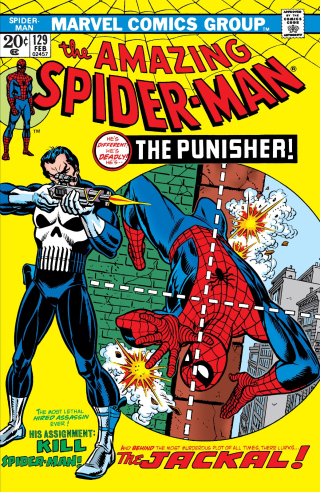 That���s not how he started, of course. He began as a villain. I have the Spider-Man comic in which he first appears, duped by another villain called The Jackal to make Spidey his next target. Here, the Frank Castle is basically a hitman who murders criminals. Yes, he���s got a tragic backstory. But at no point in that story do we mistake him for a hero. He���s a murderer. It���s just that he murders other murderers.
That���s not how he started, of course. He began as a villain. I have the Spider-Man comic in which he first appears, duped by another villain called The Jackal to make Spidey his next target. Here, the Frank Castle is basically a hitman who murders criminals. Yes, he���s got a tragic backstory. But at no point in that story do we mistake him for a hero. He���s a murderer. It���s just that he murders other murderers.
And that���s where things get dicey. This was the 1970s, the heyday of Revenge movies. Of the ���antihero���.
By definition, an antihero is a protagonist who has none of the qualities of a hero, such as idealism, courage, or morality. Tony Soprano, Walter White, the Man With No Name. All defined by their moral ambiguity.
Antiheroes are great. Edgy. Very James Dean. I enjoy a good antihero as much as the next person. I love Rorschach in Watchmen.
But here���s the rub ��� when all our heroes are antiheroes, what does that say about us?
The Punisher proved popular enough to warrant another appearance. Then another, and another, then guest appearances in other comics. Somewhere along the line, he became the lead, with his own comic. Then a second series. Then a third. Then three movies.
The villain had become the hero ��� not even an antihero, but a straight-up Marvel hero, often equated with Wolverine and Ghost Rider. Only trouble with that is, Frank didn���t change ��� or if he did, it was only cosmetic, becoming more ruggedly handsome. But his methods didn���t change, nor did his goals. No, the Punisher didn���t change. Only our acceptance of him did.
Now, some Punisher comics are really good. Some are violence porn. Some are not just awful, but misguided (the time he began shooting at jaywalkers and litterers, or his time in blackface). All of them were guilty of that thing I hate most in modern action stories. I call it A-Teaming ��� a gazillion machine guns firing, all of them missing. No stray bullets killing civilians, the hero only ever getting a pretty flesh wound. Otherwise he���s able to dodge and outrun a hail of bullets. That���s a very dangerous myth, one that we continue to spread in all our action stories. Sorry, kids, you can���t outrun a bullet.
I was profoundly glad when his various series just seemed to peter out. Interest had waned. I had hoped we, as a culture, had gotten Frank Castle out of our system.
Then came the Marvel Netflix series Daredevil, which uses violence excellently well (see: the hallway fight, the stairwell fight). Violence with cost, for a purpose. The second season promised to introduce the Punisher, and I was���
Excited. I mean it. I was genuinely excited.
You see, the best use of the Punisher ever was in the pages of Daredevil. There they had the conversation about the nature of vigilantism, of methods and motives, of goals and results. Written by Frank Miller (before his crazy fascist days), one particular debate between Daredevil and the Punisher was profound. Frank Castle served as Matt Murdock���s dark mirror. He was not a hero, but a foil to our hero, which made him so much more compelling. There was no mistaking him as a role model. Instead, he challenged our role model to question himself. Therein lies great storytelling.
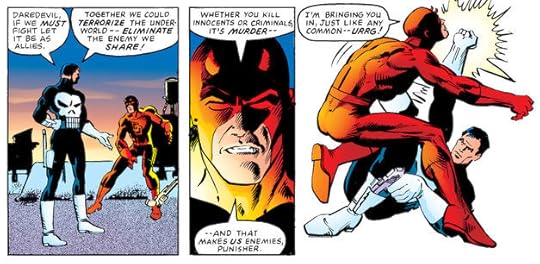 That���s the thing about antiheroes. We only recognize them in the face of actual heroism.
That���s the thing about antiheroes. We only recognize them in the face of actual heroism.
Imagine my joy when that exact debate ended up on the screen. After countless many iterations in comics and in film, someone had finally figured out the perfect way to use the Punisher. I was not only quite impressed. I was relieved.
Then I heard they were giving him his own series, and felt sick. It had happened again. We had mistaken the foil for the hero. We had looked at the complex villain/antihero and decided, because he only murdered murderers, that we could make him a hero.
I usually binge the Marvel shows. Not Iron Fist, of course ��� couldn���t make it beyond the first episode of that one. But all the rest, I���ll binge them the day they drop. (First season Jessica Jones is the best, followed by both Daredevils. Luke Cage is terrific for the first half of the series, then completely loses the thread, which is a crime).
When Punisher dropped, I didn���t want to watch it. I was afraid of pure gun fetishing. We���re living in a time of mass-shootings. Two people I cared about died from gun violence. For all that I work with violence in my art every day, I had no interest in sexy gun imagery.
I should have known better. They folks at Marvel/Netflix did a terrific job. When there���s violence in the series, it hurts. It has real consequences. Sure, Frank should have died at least five times over the course of the thirteen episodes. But this is a Marvel show, we can suspend a little disbelief.
Then we got to the end, and they almost did it. Frank has achieved his mission. He has punished all the people responsible for the murder of his wife and children. Two are still alive, but Frank has arranged for them to be taken down. He���s near death, and the ghostly spirit of his wife appears to him, reaching for him���
And he rejects her. Because revenge was now more important to him than peace.
How I wish the series had ended there. I mean, sure, I loved seeing the origin of Jigsaw (not the Saw killer, the comic book villain). But the last thing I needed was another gun fight. I didn���t want another set of civilians in peril. I especially didn���t want the government to make the insane decision to let him go free, because reasons.
No, I wanted the series to end on that most powerful moment. He���s been dreaming of his wife through the whole series. But when the time comes to join her, he is too in love with violence to embrace her. It���s not the power of life demanding he stay alive. It���s the power of killing that makes him refuse to die. He has nothing to live for but revenge. Yet that���s all he now wants.
Revenge has ruined him. Punished him.
They almost got that point across. He was almost perfectly tragic. Man, what an arc! But then they had to go and make him the hero one last time. Because the Punisher is a character forever teetering on the edge of the hero/villain divide, creators invariably make the error of giving him a heroic end, instead of a tragic one.
That���s the Tragedy of the Punisher. We keep trying to make Frank into a hero, when he���s always the first to tell you he���s not.
April 20, 2018
Meditations on Violence, Vol. 1
Lately I've been thinking a lot about violence.
This is nothing particularly new. I write historical novels that involve war and swashbuckling adventure. I act in classical theatre, with swordfights galore. I design violence for the stage and for film, and teach forms of theatrical violence. Violence is very much at the heart of my professional life.
Perhaps that's why violence is making me more and more uncomfortable.
Last night I watched the trailer for the new Denzel Washington film, The Equalizer 2. It made me profoundly sad. I mean, soul-crushingly sad. Denzel is an amazing actor, one I love to watch. The film looks well-made, and if its plot looks pathetically predictable - man who rights wrongs finds out his (female) friend is murdered, so he's out for revenge, and this time it's personal - it will likely be well-executed, hitting all the rote beats of such a familiar tale.
And therein lies my deep disquiet. It is a familiar tale. Far too familiar. The American Revenge Fantasy has become its own genre.
It's certainly not new. The 1970s were rife with films of this particular stripe. The Outlaw Josey Wales. Death Wish. High Plains Drifter. And overseas you find Get Carter and the original Mad Max. In them all, a lone man steps outside the law to effect what he sees as justice.
I'll say it up front, those are all films I have watched and enjoyed. I have the same visceral response to guns firing and bad guys getting their just desserts as the next guy. The trouble comes when we start looking to those movies for heroes. For role models. For how things are supposed to be. In short, when they cease to be unique, and instead become appallingly familiar.
These films never went entirely away, but I'd say they were revived with Liam Neeson's Taken. Since then we've had John Wick, Jack Reacher, The Equalizer, and even a remake of Death Wish. In them all, a man with special skills takes the law into his own hands to get revenge.
Again, Revenge Stories have been around as long as we've had literature. Achilles seeks revenge against Hector. Hamlet wants revenge on Claudius. Captain Ahab seeks revenge against the great white whale. These are all classic tales, rightly in the center of Western Literature.
But those characters all have something in common besides revenge. They are all doomed. Their lust for vengeance leads them to their own graves. Which is why these stories used to be called 'Revenge Tragedies'. Today they have morphed into something far more disturbing - 'Revenge Fantasies'.
Why are they fantasies, you ask? First, in none of those movies would the hero have survived the violence they perform. So we have immediately embued them with greater-than-human abilities. While we can accept this when watching Captain America get shot and keep fighting, we should be less comfortable with a mere mortal surviving what should be mortal wounds.
Second, the focus is not upon justice, but upon violence. The camera lingers on the snapping bone, the smoking gun, the bloodstained floor. If we have learned to do anything in a hundred years of cinema, we have mastered the art of displaying violence. It is a form of fetish, an erotica that we have no qualms about mass-producing and marketing. Sex on film is far more controversial than shooting a woman in the head. Nudity is notable, murder is mundane.
Third, the villains are invariably 'other'. They are foreign, in fact or else in spirit. They are whoever America is willing to demonize at present. Black, Latinx, Middle Eastern, Asian - whoever they are, they are by necessity faceless and homogenous outsiders, threats by their very existence. In the opening of the Equalizer 2 trailer, they're Turkish mobsters.
The best stories are memorable for their villains. But who are the villains in Revenge Fantasies? Try to remember their names. Hell, if the name of the hero isn't in the title, do you even remember it? They are avatars for brutality, and their targets might as well be paper silhouettes, so thinly are they drawn. They exist to be brutalized. That is all.

Even PG violence has its unintended consequences upon society. My father was raised on The Lone Ranger, who never killed, but could always shoot the gun out of the bad guy's hand. I have to think that this mindset leads us to the myth of 'the good guy with a gun' that is, like the Lone Ranger, a complete fantasy.
But it's the Revenge Fantasy that I find so utterly disturbing. Because it never ends. We have divorced violence from consequence in our storytelling, for the sake of profit. In a great story, a noble story, Liam Neeson's character in Taken would have died saving his daughter. He would have died so she could live. That would have provided the deep catharsis of Hamlet, or The Iliad. The idea is to see where such a path leads - destruction, both of the body and the soul. But that prevents the possibility of a sequel, or two, or a spin-off TV series. Profit over profundity.
In none of the modern Revenge films does the hero die. Meaning there is no cost to working outside the law. No cost to taking lives, even ones belonging to those portrayed as criminals or lowlifes. No cost to murder. Because there is always more vengeance to be had in the next film.
Violence without cost in our media leads to violence without thought of cost in real life. Think of American Gun Culture. Of Rape Culture. Of Toxic Masculinity. And ask - who are our heroes today? Who in the stories we tell do we red-blooded American males aspire to be?
I'm not against violence in the stories we tell. Remember, my livelihood depends upon violence. All my training is in violence, how to perform it safely in order to entertain an audience. But I think the way we depict violence does have an effect on how we perceive it. How can it not? The reasons for violence are as important as its consequences. Justice, I can accept. Revenge, I no longer can. It turns my stomach.
There's a reason the violence in Indiana Jones and Captain America doesn't trouble me. Just as there's a reason the violence in Looney Tunes doesn't bother me. I know it's not meant to be real. But the very nature of the Revenge Fantasy is to present it in a real-world context. And the fact that these fantasies of dreadful violence are so common, so ubiquitous, so definitive to the American character, that it helps create the toxic masculinity that affects men today.
Because we think of the violence, but not the justice. Or the consequence.
A Revenge Tragedy can be art. A Revenge Fantasy can only lead to pain, and real tragedy.
I'm gonna keep thinking about this. I'll let you know what I come up with.
December 9, 2017
THE MASTER OF VERONA Audiobook
The audiobook for THE MASTER OF VERONA is finally here! After weeks spent recording, re-recording, even rewriting pieces to better flow from the lips, then more weeks as my producer put it all together with the help of an audio proofer and several listeners, it is now, at last, available to you.
You can purchase it on Audible or iTunes today, and on every major audiobook retailer next week. Meanwhile I'm looking into creating a link to buy it direct from me. But don't wait - get it today!
Huge thanks to my producer, Judith West, for guiding me through this process. Even with almost 30 years of professional acting behind me, this was a new skill-set, one that was both frustrating and joyful. The best part is that even I can listen to the final product and actually enjoy the story, only cringing over that word choice or that line delivery maybe once a chapter. Can't wait until January to start again with Falconer...
If you are not an Audible member, you can get a FREE copy of The Master Of Verona by clicking here. If you're already a member, please consider this a lovely gift for yourself or someone else this holiday season.
Let me tell you a story...
December 8, 2017
THE PRINCE'S DOOM Cover Reveal!
On Tuesday the new cover for the fourth novel in the Star-Cross'd series hit the web, and today I'm happy to share it with you here!

